|
|
|
Sort Order |
|
|
|
Items / Page
|
|
|
|
|
|
|
| Srl | Item |
| 1 |
ID:
123316
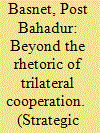

|
|
|
|
|
| Publication |
2013.
|
| Summary/Abstract |
Over the past few years, 'trilateral economic cooperation' and 'vibrant bridge' have become buzzwords in Nepal's foreign policy discourse, and have also caught the popular imagination at home in India. These proposals have generated both curiosity and anxiety in Delhi's diplomatic and academic circles that are otherwise largely indifferent to Nepal. The Chinese diplomats in Delhi also raising the issue with the Indian officials has added to India's anxiety all the more. With some notable exceptions (e.g., C. Raja Mohan, 'Three to Tango', The Indian Express, 7 May 2013), there is more or less consensus in India that such proposals from Nepal, if received formally, should be rejected outright, although some have prescribed the 'wait and see' approach as the best policy option for now. Moreover, the proposal has received prominence at a time when media reports about 'Chinese incursion into Ladakh' have flummoxed many policymakers in Delhi. While the Indian mandarins now seem to be handling the issue somewhat prudently, the supposed Chinese 'forward policy' across the Himalayas has already set alarm bells ringing, bringing back memories of the 'uncalled-for Chinese aggression' on India in 1962. It is in this context-'Chinese manoeuvres' across the Himalayas-that the rationale behind such plans in the changing dynamics of India-China-Nepal relations should be analysed.
|
|
|
|
|
|
|
|
|
|
|
|
|
|
|
|
| 2 |
ID:
152969
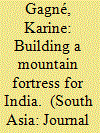

|
|
|
|
|
| Summary/Abstract |
This article examines the relationship between affect and the state in post-colonial India, foregrounding sympathy as a feeling that arises from the embodied encounters and interactions between the state and a local population through state-building in the Himalayas. It establishes the emergence of sympathy in the materiality of the Himalayas and in the historical conjuncture of the passage to Indian nationhood in Ladakh, which was marked by the mobilisation of the local population in the defence of the territory of India amid the first Indo-Pakistani war (1947–48). This article argues that sympathy, in leading the state to reimagine the population of Ladakh, is integral to the reconfiguration of the region into a border area and to the rethinking of the sovereignty of the Indian state at its Himalayan frontier.
|
|
|
|
|
|
|
|
|
|
|
|
|
|
|
|
| 3 |
ID:
106186
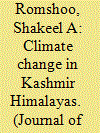

|
|
|
| 4 |
ID:
120945
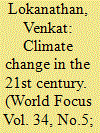

|
|
|
| 5 |
ID:
098878


|
|
|
|
|
| Publication |
2010.
|
| Summary/Abstract |
By considering bickering, gossip and similar artful kinds of talk that reproduce social categories in a central Himalayan town, it is possible to see that participants in such talk collude in constructing a social landscape that grounds the relational distinctions foregrounded in those conversations. Following on from discussions that suggest anthropology of the environment must consider other social relations, here it is proposed that the environment is inescapably part of relational social distinctions. Collusion in the production of such shared landscapes, it is argued, is a key aspect of achieving ordinary life and, in certain contexts, can become the basis for resistance to the imposition of unwanted categorical distinctions.
|
|
|
|
|
|
|
|
|
|
|
|
|
|
|
|
| 6 |
ID:
176642
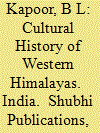

|
|
|
|
|
| Publication |
India, Shubhi Publications, 2021.
|
| Description |
xvii, 195p.Hbk
|
| Standard Number |
9788182900615
|
|
|
|
|
|
|
|
|
|
|
|
Copies: C:1/I:0,R:0,Q:0
Circulation
| Accession# | Call# | Current Location | Status | Policy | Location |
| 059956 | 954.52/KAP 059956 | Main | On Shelf | General | |
|
|
|
|
| 7 |
ID:
161242
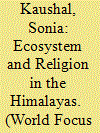

|
|
|
|
|
| Summary/Abstract |
The contribution of human in changing and quite often destroying biodiversity is a matter of fact. The world community is fast becoming aware of this anthropogenic menace and beginning to take necessary measures in the form of sustainable Development Goals. It happened because of the ‘greed’ replacing ‘need’ and the biodiversity of the weak, marginalized, ruled and enslaved was usurped by the powerful, imperial and colonial masters. Even after these area became autonomous and independent, the excessive exploitation of the biodiversity resources continued uninterrupted.
|
|
|
|
|
|
|
|
|
|
|
|
|
|
|
|
| 8 |
ID:
193579


|
|
|
|
|
| Summary/Abstract |
The Himalayan region is renowned as a powerhouse of Asia. Despite its abundant natural resources, youthful population, and strategic location between two rapidly developing Asian economies, the social and economic conditions in the Himalayan region, particularly in Nepal and Bhutan, have remained consistently underdeveloped. Various factors contribute to this, including climate change-induced disasters, political instability, strained bilateral relations between lower and upper riparian countries, and inadequate resource management. This article aims to address the existing research gap by exploring the energy potential of the Himalayan region and its viability for sustainable economic growth in the face of increasing global temperatures and climate-induced energy crises. The article asserts that, unless the region diversifies its energy sources to include other renewables, the Himalayan region (comprising Nepal, Bhutan, and the Indian Himalayan States-IHS) may not be able to serve as a stable hydro energy supplier to the South Asian region. This is due to inherent challenges and the strategic competition between India and China, both regionally and globally.
|
|
|
|
|
|
|
|
|
|
|
|
|
|
|
|
| 9 |
ID:
145376
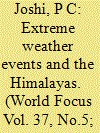

|
|
|
|
|
| Summary/Abstract |
Kedarnath and Kashmir floods teach us some very important lessons which may go a long way in management of flood disasters. The first lesson is that the climate change is a reality and we need to prepare for more frequent and severe hydrometeorological hazards in the coming years.
|
|
|
|
|
|
|
|
|
|
|
|
|
|
|
|
| 10 |
ID:
135139
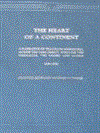

|
|
|
|
|
| Publication |
New Delhi, Asian educational services, 2007.
|
| Description |
xvii, 332p.Hbk
|
| Contents |
Old Publication
|
| Standard Number |
812060850X
|
|
|
|
|
|
|
|
|
|
|
|
Copies: C:1/I:0,R:0,Q:0
Circulation
| Accession# | Call# | Current Location | Status | Policy | Location |
| 058005 | 915.1/YOU 058005 | Main | On Shelf | General | |
|
|
|
|
| 11 |
ID:
025622


|
|
|
|
|
| Publication |
DelhI, Vikas Publications, 1970.
|
| Description |
174p.;mapsHbk
|
|
|
|
|
|
|
|
|
|
|
|
Copies: C:1/I:0,R:0,Q:0
Circulation
| Accession# | Call# | Current Location | Status | Policy | Location |
| 007834 | 910.91095496/TIC 007834 | Main | On Shelf | General | |
|
|
|
|
| 12 |
ID:
095660
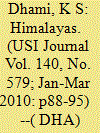

|
|
|
| 13 |
ID:
148907
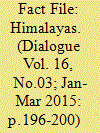

|
|
|
| 14 |
ID:
148897
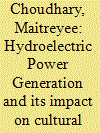

|
|
|
| 15 |
ID:
117156
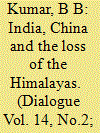

|
|
|
| 16 |
ID:
185654
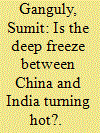

|
|
|
|
|
| Summary/Abstract |
After a deadly June 2020 clash between Chinese and Indian troops on the contested border in the Himalayas, both sides eventually agreed to pull back their forces from the immediate vicinity of the border. But neither country made any notable concessions, and tensions remained high as a series of skirmishes continued. With authoritarian nationalists in charge in Beijing and New Delhi, backed by public opinion, compromise has proved hard to reach.
|
|
|
|
|
|
|
|
|
|
|
|
|
|
|
|
| 17 |
ID:
029529
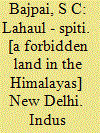

|
|
|
|
|
| Publication |
New Delhi, Indus Publishing Company, 1987.
|
| Description |
xi, 164p.Hbk
|
| Standard Number |
8185182019
|
|
|
|
|
|
|
|
|
|
|
|
Copies: C:1/I:0,R:0,Q:0
Circulation
| Accession# | Call# | Current Location | Status | Policy | Location |
| 028326 | 954.52/BAJ 028326 | Main | On Shelf | General | |
|
|
|
|
| 18 |
ID:
181953


|
|
|
|
|
| Summary/Abstract |
Since 1984 the Indian and Pakistani armies have been locked in the world’s highest war on Siachen Glacier in the Karakoram Himalaya. This remote location is the world’s only nuclear trijunction as well as a source of drinking water for significant portions of India and Pakistan, and its possession is considered by both governments to be key to their national security. In the past, alpine battles were fought predominantly on glaciers with a precipitation-dominated accumulation type; Siachen, however, gains most of its new ice mass from avalanches and icefalls. This has presented unique challenges in tactics and logistics, rendering many of the strategies of modern conventional warfare useless, and the style of mountain warfare these challenges have produced has impacted both the combatants and the glacier itself. Existing literature on Siachen, while it discusses the verticality of the conflict, has done little to analyze the singular nature of warfare on a high-altitude glacier with an avalanche-heavy accumulation type. This paper draws on USGS Landsat data, glaciological mass balance studies, hydrological studies, firsthand combat accounts and historical reviews of the region to examine the unique tactics, logistics and impact of warfare on Siachen Glacier.
|
|
|
|
|
|
|
|
|
|
|
|
|
|
|
|
| 19 |
ID:
094335
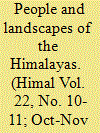

|
|
|
| 20 |
ID:
152035
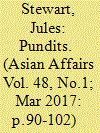

|
|
|
|
|
| Summary/Abstract |
This article provides an overview of the development of the exploration, mapping and surveying of the frontier territories of India in the 19th century and the context of the Great Game with Russia. It pays particular attention to the Pundits, the native surveyors trained by British officers who made long surveying journeys into the borderlands of the Himalayas and Tibet. It gives an account of the explorations of pundits including Nain Singh, Kishen Singh, Sarat Chandra Das, Kintup, and Ugyen Gatso.
|
|
|
|
|
|
|
|
|
|
|
|
|
|
|
|
|
|
|
|
|